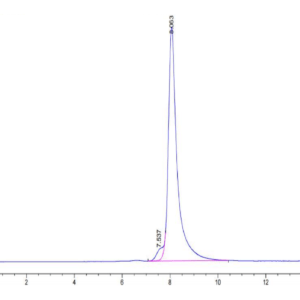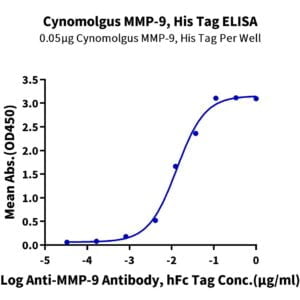| Weight | 1 lbs |
|---|---|
| Dimensions | 9 × 5 × 2 in |
| accession | Q96B86 |
| express system | HEK293 |
| product tag | C-His-Avi |
| purity | > 95% as determined by Tris-Bis PAGE;> 95% as determined by HPLC |
| background | Repulsive guidance molecule (RGM) is a glycosylphosphatidylinositol (GPI)-anchored glycoprotein that has diverse functions in the developing and pathological central nervous system (CNS). The binding of RGM to its receptor neogenin regulates axon guidance, neuronal differentiation, and survival during the development of the CNS. RGMa induces T cell activation in experimental autoimmune encephalomyelitis (EAE), which is the animal model of multiple sclerosis (MS). RGM is expressed in pathogenic Th17 cells and induces neurodegeneration by binding to neogenin. |
| molecular weight | The protein has a predicted MW of 44.5 kDa. Due to glycosylation, the protein migrates to 45-48 kDa based on Tris-Bis PAGE result. |
| available size | 100 µg, 500 µg |
| endotoxin | Less than 1EU per μg by the LAL method. |
Human RGMa Protein 4712
$270.00 – $900.00
Summary
- Expression: HEK293
- Functional: Yes (ELISA)
- Amino Acid Range: Cys48-Gly422
Human RGMa Protein 4712
| protein |
|---|
| Size and concentration 100, 500µg and lyophilized |
| Form Lyophilized |
| Storage Instructions Valid for 12 months from date of receipt when stored at -80°C. Recommend to aliquot the protein into smaller quantities for optimal storage. Please minimize freeze-thaw cycles. |
| Storage buffer Shipped at ambient temperature. |
| Purity > 95% as determined by Tris-Bis PAGE |
| target relevance |
|---|
| Repulsive guidance molecule (RGM) is a glycosylphosphatidylinositol (GPI)-anchored glycoprotein that has diverse functions in the developing and pathological central nervous system (CNS). The binding of RGM to its receptor neogenin regulates axon guidance, neuronal differentiation, and survival during the development of the CNS. RGMa induces T cell activation in experimental autoimmune encephalomyelitis (EAE), which is the animal model of multiple sclerosis (MS). RGM is expressed in pathogenic Th17 cells and induces neurodegeneration by binding to neogenin. |
| Protein names Repulsive guidance molecule A (RGM domain family member A) |
| Gene names RGMA,RGMA RGM |
| Protein family Repulsive guidance molecule (RGM) family |
| Mass 9606Da |
| Function Member of the repulsive guidance molecule (RGM) family that performs several functions in the developing and adult nervous system. Regulates cephalic neural tube closure, inhibits neurite outgrowth and cortical neuron branching, and the formation of mature synapses. Binding to its receptor NEO1/neogenin induces activation of RHOA-ROCK1/Rho-kinase signaling pathway through UNC5B-ARHGEF12/LARG-PTK2/FAK1 cascade, leading to collapse of the neuronal growth cone and neurite outgrowth inhibition. Furthermore, RGMA binding to NEO1/neogenin leads to HRAS inactivation by influencing HRAS-PTK2/FAK1-AKT1 pathway. It also functions as a bone morphogenetic protein (BMP) coreceptor that may signal through SMAD1, SMAD5, and SMAD8. |
| Catalytic activity #N/A |
| Subellular location Cell membrane ; Lipid-anchor, GPI-anchor . |
| Structure Interacts with NEO1, BMP2 and BMP4. |
| Post-translational modification Autocatalytically cleaved at low pH; the two chains remain linked via two disulfide bonds. |
| Target Relevance information above includes information from UniProt accession: Q96B86 |
| The UniProt Consortium |
Data
Publications
Publications
| pmid | title | authors | citation |
|---|---|---|---|
| We haven't added any publications to our database yet. | |||
Protocols
| relevant to this product |
|---|
Documents
| # | ||
|---|---|---|
| Please enter your product and batch number here to retrieve product datasheet, SDS, and QC information. | ||

















